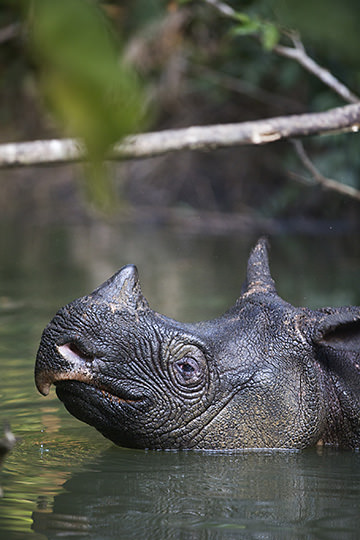The Javan Rhino is a critically endangered species, with no more than 35 to 50 individuals left in the wild. In order to capture some images of the rare animal with a high resolution digital camera, wildlife photographer Stephen Belcher headed to Indonesia with the EOS 5DS Mark III. (Text and Photos Stephen Belcher)

Only between 35 to 50 individuals are left
I recently concluded an expedition to Ujung Kulon National Park (UKNP) in Indonesia to photograph the extremely rare Sunda rhinoceros (Rhinoceros sondaicus), or lesser one-horned rhinoceros, more popularly known as the Javan rhino. Only between 35 to 50 individuals are left in the wild, and they all reside in UKNP. None is held in captivity.
From the outset, it was clear this was going to be a very challenging project, given that the Javan rhino is rarely ever seen, even by the national park rangers, and has only ever been photographed a handful of times. Most images are from trail cameras that provide only low-resolution pictures. I wanted to be the first to take high-resolution still images and, if possible, video as well. Capturing film footage would be especially difficult, as many people had told me that I would be very lucky to even catch a glimpse of one.

EOS 6D / EF16-35mm f/2.8L II USM / f/13 / 1/50sec. / ISO 800
If I were to have any success, I needed to plan carefully and have the best gear. I decided to make five camera traps using the Canon EOS 6D with the EF16-35mm f/2.8L II USM and the EF17-40mm f/4L USM lenses - a combination of full-frame sensors and razor-sharp optics.
But as this animal is extremely difficult to photograph, I also planned to use a boat to patrol the rivers and try and photograph the rhino using a handheld camera. For this I needed a camera that could shoot high-quality images in low light without using flash - a flash would scare off the rhino or result in my first encounter being my last! - and if the opportunity arose, take high-definition video as well. So I used the Canon EOS 5D Mark III with the EF70-200mm f/2.8L IS II USM lens.

EOS 6D / EF70-200mm f/2.8L IS II USM / f/8 / 4sec. / ISO 800 (Taken using a camera trap)
Incredible noise-free images allowed me to achieve my goal
This was the first time I had used the EOS 5D Mark III and it didn't disappoint. The body is designed to resist dust and water, so I could use the camera even when it was drizzling. But what really impressed me was the image quality. I had 14 sightings of Javan rhinos from my boat and almost all were in low-light conditions around sunrise and dusk with the rhinos being close to the riverbank and in the shade. To take clear, sharp images, I needed to ensure my shutter speed was kept as high as possible, and this meant shooting with ISO settings from 2000 to 12,800. The 5D Mark III's incredible noise-free images allowed me to achieve my goal - capturing the first high-resolution still images of the Javan rhino.

EOS 5D Mark III / EF70-200mm f/2.8L IS II USM / f/2.8 / 1/500sec. / ISO 2000
Even more impressive was how the 5D Mark III allowed me to switch quickly and easily from stills to video, so I also managed to get close-up HD video of this incredibly rare animal. The image stabilisation offered by the IS lens made it possible to capture sharp images and video, even though I was hand-holding the camera and shooting from a small inflatable boat.
The EF70-200mm f/2.8L IS II USM, being a zoom lens, allowed me to rapidly frame the picture as I wanted, and the large aperture made the subject stand out from the background foliage stunningly well.

is a wildlife photographer whose passion for photography has taken him to some of the remotest locations in the world to photograph the widest possible variety of endangered species.







































